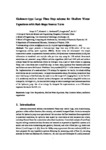Godunov-type large time step scheme for shallow water equations with bed-slope source term
| dc.contributor.author | Xu, R | |
| dc.contributor.author | Borthwick, Alistair | |
| dc.contributor.author | Ma, H | |
| dc.contributor.author | Xu, B | |
| dc.date.accessioned | 2022-03-06T15:13:46Z | |
| dc.date.available | 2022-03-06T15:13:46Z | |
| dc.date.issued | 2022-01-30 | |
| dc.identifier.issn | 0045-7930 | |
| dc.identifier.other | 105222 | |
| dc.identifier.uri | http://hdl.handle.net/10026.1/18889 | |
| dc.description.abstract |
This paper presents a Godunov-type large time step (LTS) solver of the non-homogeneous shallow water equations (SWEs). Source terms are decomposed into simple characteristic waves in approximate Riemann solvers (ARS) and exact Riemann solvers (ERS), and information is transferred over multiple cells per time step using the LTS method. Benchmark simulations are presented using different solution algorithms (ARS and ERS with and without entropy fixes) for two rarefactions driven by divergent flow, a pair of bores driven by opposing flows, and a dam break over a shelf-like step. In these cases, spurious flow discontinuities and oscillations can occur for Courant–Friedrichs–Lewy number (CFL) > 1 in the absence of an entropy fix. Implementation of a weak-solution LTS entropy fix improves the results, but shock shifting nevertheless occurs in certain cases. The paper also considers steady, frictionless, transcritical flow over a bed hump. In this final case, the model is run for integer CFL ranging from 1 to 10. For CFL ≤ 3, satisfactory results are obtained (without divergence and oscillation) using ARS without an entropy fix. For larger CFL, the results either diverge or exhibit convergent oscillations downstream of the hydraulic jump. Use of an entropy fix designed for implementation in an LTS scheme improves the results for CFL ≤ 5. | |
| dc.format.extent | 105222-105222 | |
| dc.language | en | |
| dc.language.iso | en | |
| dc.publisher | Elsevier | |
| dc.title | Godunov-type large time step scheme for shallow water equations with bed-slope source term | |
| dc.type | journal-article | |
| dc.type | Journal Article | |
| plymouth.volume | 233 | |
| plymouth.publication-status | Published | |
| plymouth.journal | Computers and Fluids | |
| dc.identifier.doi | 10.1016/j.compfluid.2021.105222 | |
| plymouth.organisational-group | /Plymouth | |
| plymouth.organisational-group | /Plymouth/Faculty of Science and Engineering | |
| plymouth.organisational-group | /Plymouth/Faculty of Science and Engineering/School of Engineering, Computing and Mathematics | |
| plymouth.organisational-group | /Plymouth/Users by role | |
| plymouth.organisational-group | /Plymouth/Users by role/Academics | |
| dcterms.dateAccepted | 2021-10-25 | |
| dc.rights.embargodate | 2022-12-10 | |
| dc.rights.embargoperiod | Not known | |
| rioxxterms.versionofrecord | 10.1016/j.compfluid.2021.105222 | |
| rioxxterms.licenseref.uri | http://www.rioxx.net/licenses/all-rights-reserved | |
| rioxxterms.licenseref.startdate | 2022-01-30 | |
| rioxxterms.type | Journal Article/Review |


